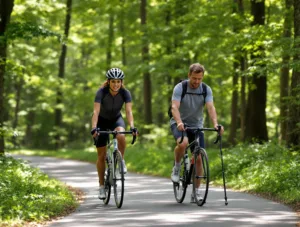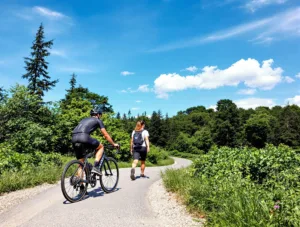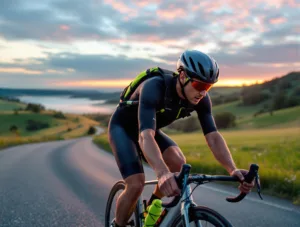Does Cycling Help Get Rid of Belly and Butt Fat? The Truth About Targeted Fat Loss
Introduction
In the quest for a toned midsection and a firmer backside, many people turn to cycling as a potential solution. But does cycling really help burn belly and butt fat, or is it just another fitness myth? With the growing popularity of cycling—whether outdoors, in spin classes, or on stationary bikes—it’s important to understand how this form of exercise impacts fat loss, particularly in stubborn areas like the abdomen and glutes.
This article dives deep into the science of fat loss, the effectiveness of cycling for burning fat, and whether it can truly target specific problem areas. We’ll explore how cycling compares to other exercises, the role of diet in fat reduction, and practical strategies to maximize results. By the end, you’ll have a clear understanding of whether cycling is the right choice for your fitness goals.
Understanding Fat Loss: Can You Target Specific Areas?
Before examining cycling’s role in fat reduction, it’s crucial to address a common misconception: spot reduction. Many people believe that exercising a particular body part will burn fat in that area. Unfortunately, scientific evidence does not support this idea.
How Fat Loss Works
Fat loss occurs when the body burns more calories than it consumes, leading to a caloric deficit. When this happens, the body taps into fat stores for energy. However, where fat is lost first is largely determined by genetics, hormones, and overall body composition.
- Men tend to store fat in the abdominal area first and lose it last.
- Women often store excess fat in the hips, thighs, and buttocks, making these areas more resistant to fat loss.
While exercises like cycling can strengthen and tone muscles in the legs and glutes, they don’t directly burn fat from those areas alone. Instead, consistent cardio, strength training, and a proper diet contribute to overall fat loss, which eventually leads to a reduction in belly and butt fat.
Cycling for Fat Loss: How Effective Is It?
Cycling is an excellent cardiovascular exercise that burns calories, improves endurance, and strengthens the lower body. But how well does it contribute to fat loss?
Calorie Burn and Fat Reduction
The number of calories burned while cycling depends on factors like:
- Intensity (moderate vs. high-intensity cycling)
- Duration (30 minutes vs. 60+ minutes)
- Body weight (heavier individuals burn more calories)
On average, a 155-pound person can burn:
- 260–400 calories in 30 minutes of moderate cycling (12–14 mph)
- 500–600 calories in 30 minutes of vigorous cycling (16–19 mph or uphill)
Since 1 pound of fat equals roughly 3,500 calories, consistent cycling can contribute to fat loss over time. However, without dietary adjustments, results may be slow.
Does Cycling Tone the Butt and Thighs?
While cycling doesn’t directly burn butt fat, it does:
- Engage the glutes, hamstrings, and quadriceps, leading to muscle toning.
- Improve muscle endurance, making the lower body appear firmer.
For maximum glute activation:
- Incorporate hill climbs or resistance cycling (stationary bike with high resistance).
- Stand while pedaling to engage the glutes more.
However, if fat loss is the goal, cycling must be combined with a full-body workout and a calorie-controlled diet.
Comparing Cycling to Other Fat-Burning Exercises
While cycling is effective, how does it stack up against other workouts for belly and butt fat reduction?
1. Running vs. Cycling
- Running burns slightly more calories (about 100–150 more per hour).
- Cycling is lower impact, making it better for joint health.
- Both contribute to overall fat loss, but neither targets specific areas.
2. Strength Training vs. Cycling
- Strength training builds muscle, which increases metabolic rate.
- Compound lifts (squats, deadlifts) engage the glutes and core more effectively than cycling alone.
- A combination of cycling and strength training yields the best fat-loss results.
3. High-Intensity Interval Training (HIIT) vs. Cycling
- HIIT burns more calories in less time due to the afterburn effect (EPOC).
- HIIT cycling (sprint intervals) can be more effective for fat loss than steady-state cycling.
Best Approach: A mix of cycling, strength training, and HIIT maximizes fat loss while improving overall fitness.
The Role of Diet in Losing Belly and Butt Fat
No amount of cycling will outwork a poor diet. To lose fat effectively:
1. Maintain a Caloric Deficit
- Calculate your Total Daily Energy Expenditure (TDEE) and consume 300–500 calories less per day for steady fat loss.
2. Prioritize Protein
- Protein preserves muscle mass during weight loss and keeps you full longer.
- Aim for 0.7–1 gram of protein per pound of body weight.
3. Reduce Refined Carbs and Sugars
- Excess sugar and processed foods contribute to belly fat.
- Focus on whole grains, vegetables, and healthy fats.
4. Stay Hydrated
- Dehydration can slow metabolism and increase water retention.
Practical Tips to Maximize Fat Loss with Cycling
To get the best results from cycling:
1. Incorporate HIIT Cycling
- Alternate between 30 seconds of sprinting and 1 minute of slow pedaling for 20–30 minutes.
2. Add Resistance and Hills
- Uphill cycling engages the glutes more than flat terrain.
3. Combine with Strength Training
- Squats, lunges, and deadlifts help build muscle, boosting metabolism.
4. Stay Consistent
- Aim for at least 150 minutes of moderate cycling per week for fat loss.
Final Verdict: Does Cycling Help Lose Belly and Butt Fat?
Cycling is an effective tool for overall fat loss, including belly and butt fat, but it cannot target these areas exclusively. For best results:
- Combine cycling with strength training and HIIT.
- Follow a calorie-controlled, high-protein diet.
- Stay consistent and patient—fat loss takes time.
While cycling alone won’t magically melt away stubborn fat, it strengthens and tones the lower body while contributing to a calorie deficit. For a leaner midsection and firmer glutes, a holistic approach involving diet, cardio, and resistance training is key.
Conclusion
Cycling is a fantastic exercise for cardiovascular health, endurance, and lower-body strength. However, losing belly and butt fat requires more than just pedaling—it demands a combination of smart nutrition, varied workouts, and consistency.
If your goal is to reduce fat in these stubborn areas, use cycling as part of a broader fitness plan that includes strength training and dietary adjustments. Over time, this multi-faceted approach will yield the best results, leading to a leaner, stronger, and more toned physique.
So, hop on your bike, but remember: fat loss is a journey, not a sprint. Stay committed, and the results will follow!









Add comment